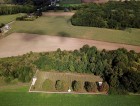 A picture from my trip today
A picture from my trip todayBlighty Valley Cemetery
View Blighty Valley Cemetery on the Commonwealth War Graves Commission websiteSomme
France
About
Blighty Valley Cemetery is down a grassy track on the main back road from Thiepval to Albert. As you reach the end of the track the cemetery opens out in front of you. Blighty Valley was the name given by the Army to the lower part of the deep valley running down South-Westward through Authuile Wood to join the river between Authuile and Aveluy; a railway was carried along it soon after July, 1916, and it was for some time an important (though inevitably a dangerous) route. Blighty Valley Cemetery was begun early in July 1916, at the beginning of the Battle of the Somme, and used until the following November. At the Armistice it contained 212 graves but was then greatly enlarged when 784 graves were brought in from the battlefields and small cemeteries to the east. Most of these graves are of young volunteers who answered Lord Kitchener's call at the start of the war and died in the 1916 Somme battle. Here are buried men who were told capturing their objectives on 1st July 1916 would be easy - they simply had to go forward after the barrage and occupy the German positions. But the attack was a disaster and the inexperienced New Army battalions suffered grievously. One of those who died on that day, and is buried here is Walter Gibson of Whissendine, who is buried in Plot V, Row A, Grave 13. The cemetery was designed by Sir Herbert Baker. Harold Dyson of Oakham School lies in Plot I, Row A, Grave 25

|
Do you know something about Blighty Valley Cemetery that hasn't been mentioned? You can add any new information and images as a contribution at the bottom of this page. |










.jpg)


.png)


.jpg)





Please wait